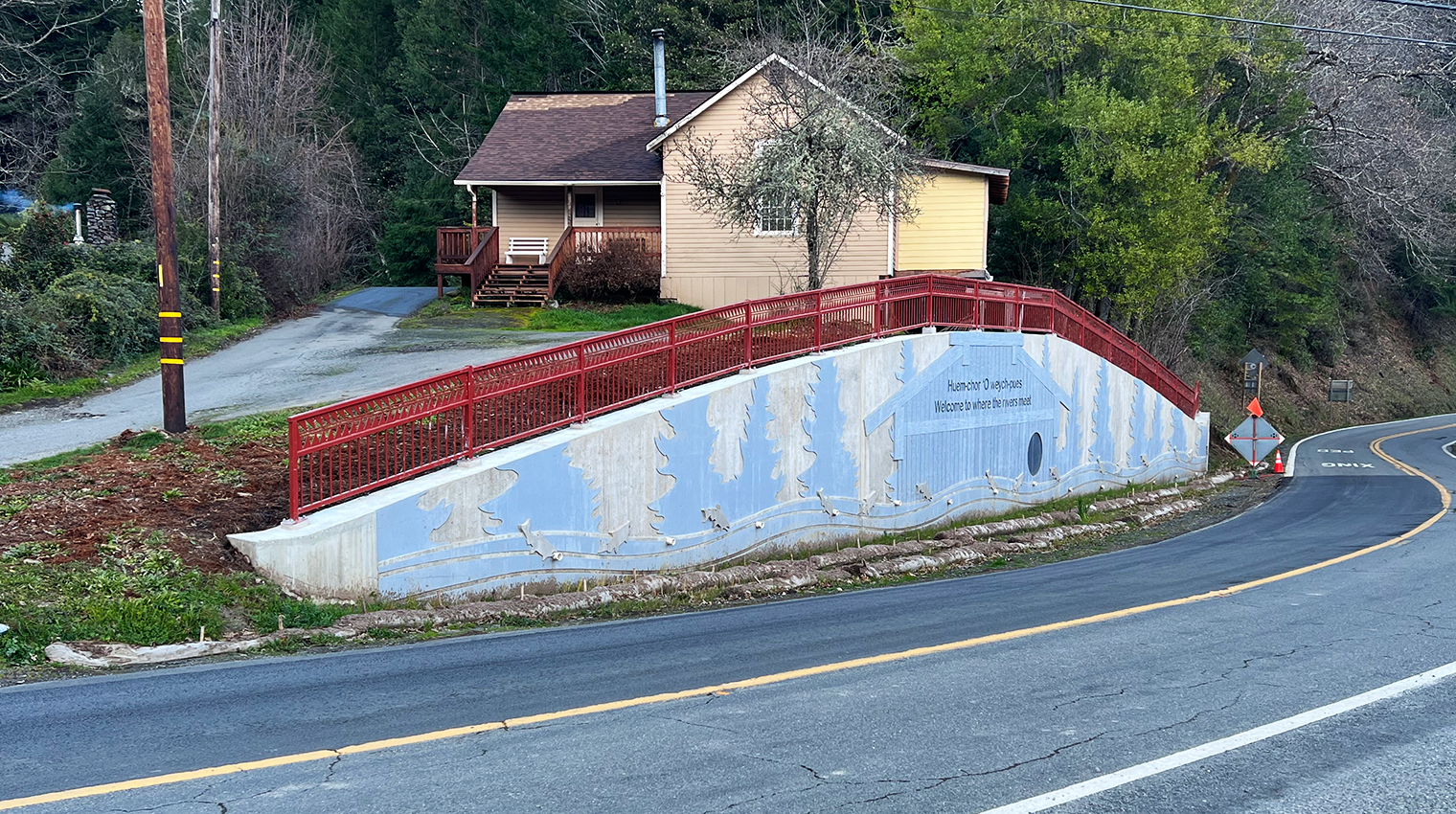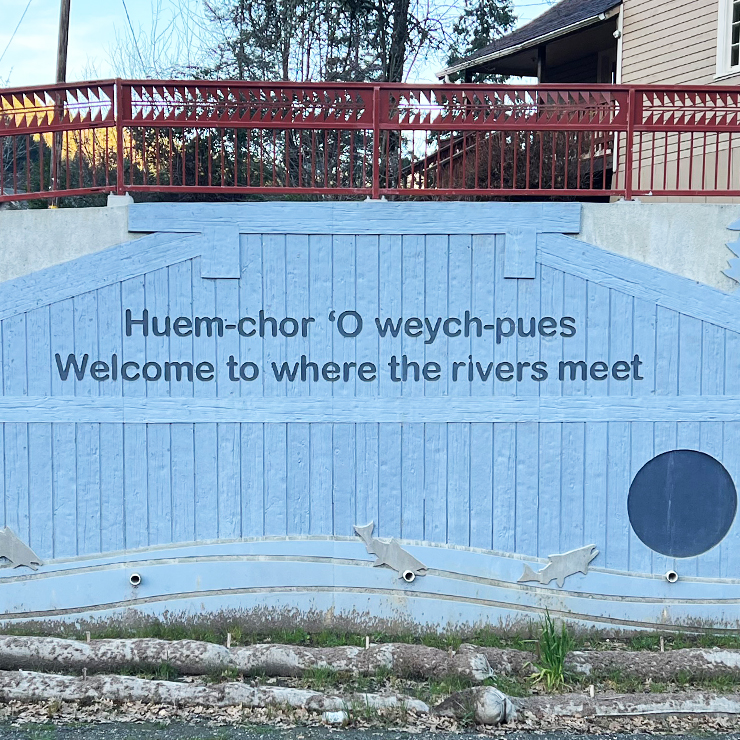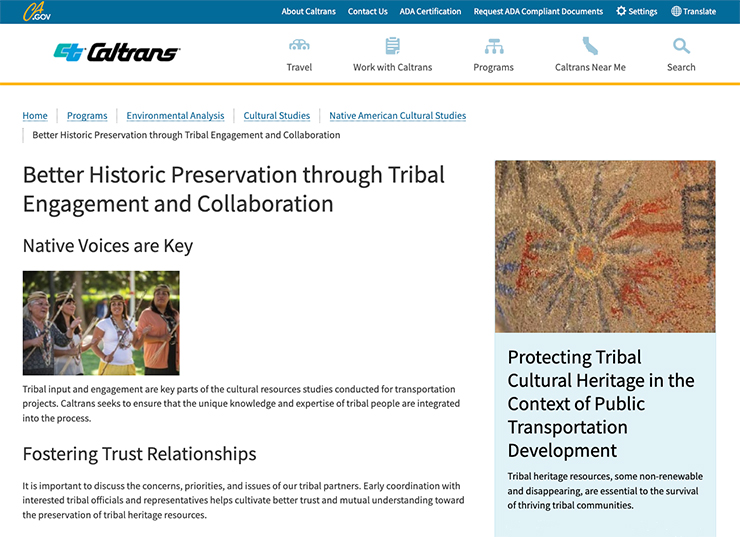Projects Honor, Protect a Way of Life

Department Dedicated to Collaborating With California’s Diverse Tribes
At the places where state roadways and Native American tribal lands intersect, Caltrans takes great care to respect and protect the safety, cultural identity and sacred lands of California’s original inhabitants.
One example of the collaboration between the department and tribal neighbors is in Caltrans’ District 1 region, the land of towering redwoods and crashing coastline that is home to the Yurok tribe, whose descendants have lived in this magical part of California long before non-Indian exploration and settlement occurred.
Caltrans and Yurok tribal representatives are now heralding the completion of the Pectah Wall Project, a shared goal to improve pedestrian safety in the village of Weitchpec on the Yurok Reservation, sited along a twisty, 44-mile portion of the Klamath River in Del Norte and Humboldt counties. (The reservation is a rare example in California of a native people not having been forcibly removed from their ancestral lands.)


U.S. Highway 101 and State Route 96 run through the 50,000-acre-plus reservation, which extends from the Pacific Ocean coastline inland to the unincorporated community of Weitchpec. State Routes 96 and 169 intersect at Weitchpec, which is also where the Klamath and Trinity rivers meet.
Tribal elders of the Yurok, a tribe whose 6,000-plus members live throughout Northern California, often walk across the state-maintained highways as they go about their daily lives and ceremonial duties.
In Weitchpec, the roadway has a store/gas station on the north side of the highway, church and community mailboxes on the south, and houses on both sides, leading to frequent pedestrian crossings.
Due to limited sight distance, drivers traveling east on SR 96 round a corner into Weitchpec and can quickly encounter people crossing the road with limited time to react, especially if they aren’t obeying the speed limit or paying attention.
Because of concerns expressed by Weitchpec community members, the Yurok Tribal Council requested safety improvements for that stretch of state highway. District 1 staff conducted two investigations in the area that confirmed the need for increased sight distance on SR 96, and Caltrans and the Yurok tribe began work toward a solution.
In assessing possible remedies, Caltrans project staff determined there was no room to widen the road by cutting into the existing bank. Any widening project would take out the church to the south, and the houses and the store parking lot to the north — both untenable propositions. With that in mind, staff determined a wall would be the best way to improve pedestrian safety.
As part of the planning process, District 1 executive staff members met with the Yurok Cultural Committee — a group of tribal members that reviews all projects in the community — to discuss potential aesthetic treatments for the wall. Many of the elders and cultural practitioners suggested design elements that a Caltrans landscape architect was able to incorporate in conceptual graphics that were presented at a tribal meeting.
The Yurok tribe presented three design proposals to all tribal members throughout Northern California. One that depicted fish, trees and river, and a dual-language welcome sign received overwhelming support. Caltrans completed the wall earlier this year, and the Weitchpec community is now enjoying the safety benefits.
The Pectah Wall Project is just one example among many of the partnerships between Caltrans and Native American tribes in the state. Here are several other recent examples:
District 7
Caltrans District 7, which encompasses Los Angeles/Ventura counties, has engaged with local Native American cultural leaders on the Wallis Annenberg Wildlife Crossing at Liberty Canyon off U.S. Highway 101 in Agoura. Once constructed, the crossing will be one of the largest urban wildlife bridges in the world and provide a safe and sustainable passage for animals between the Santa Monica Mountains and Ventura County.
In another example of Caltrans’ tribal engagement efforts, District 7 also collaborated with local tribal cultural leaders/representatives to host a museum exhibit at the district’s downtown Los Angeles office in 2019. The temporary exhibit, We Are Still Here, celebrates the contributions of four Native American tribes and 20 communities in the greater Los Angeles region. The exhibit served as a reminder of the importance of considering the unique tribal knowledge and expertise that tribes possess about their ancestral lands in the department’s approach to the identification and treatment of significant tribal heritage sites in the context of transportation project developments. The exhibit has been adapted to a virtual format for all to view and learn.
Native American Exhibit
District 4
District 4, which represents nine counties in the greater Bay Area, collaborated with the Kashia Pomo for a Cultural Landscape Project, which won the Governor’s Historic Preservation Award in 2017. Caltrans workers and representatives of the tribe, whose coastal homeland begins just north of Jenner along State Route 1, documented the Kashia Pomo’s historical and cultural association with the land. The gathered information can help Caltrans make repairs to the iconic roadway in a respectful way, avoiding conflicts with the tribe and its members. This Caltrans NewsFlash describes the project.
Helping with Native American Cultural Site Preservation
In conjunction with Caltrans’ Division of Transportation Planning and Project Delivery program, the Cultural Studies Office has developed a web-based research tool and map tool to aid in the research of California tribal heritage efforts. The Roadmap to Research webpage connects users to a database of publicly available historical and anthropological records, archives and studies in California. The Roadmap to Research site promotes research and awareness of the wealth of original source material and information for which fresh interpretations by Native Californians may be needed. This resource is intended as an access-for-all approach to guide users to original source information that might otherwise have only been known and used by academic researchers.
Find out more about how Caltrans works with Native American tribes, or request assistance on tribal consultation and diplomacy in the context of planning and transportation development activities, by visiting the Caltrans Tribal Relations webpage.
Sources: Lonora Graves, Caltrans Native American Liaison Branch Manager; Kathleen Sartorius, Project Engineer for the Pectah Wall Project, Sara Atchley Thomas, Native American Liaison, Caltrans District 1; Brandi Cottonreader, Caltrans Equal Employment Opportunity Program; Jody Brown, Caltrans Cultural Studies Office Chief, Division of Environmental Analysis.
Caltrans’ Native American Outreach Involves Multiple Offices, Regional Districts
With California home to the highest number of Native American tribes in the contiguous U.S., Caltrans recognizes the importance of communication, coordination and meaningful consultation with tribal leaders and representatives on transportation issues of local impact. There are 109 federally recognized tribal governments in the state, second only to Alaska, and approximately 80 non-federal tribal governments and affiliated nonprofit organizations recognized by the state of California.
Caltrans’ responsibilities for interacting with tribal governments are defined in its Director’s Policy 19 (Working with Native American Communities), the California State Transportation Agency’s Tribal Consultation Policy, and the Governor’s Executive Order B-10-11.
Caltrans’ Tribal Relations team based at its Sacramento headquarters provides leadership and direction that guides the Department’s diplomatic and consultation responsibilities with tribal governments. About 30 full-time employees at Caltrans work on Native American issues involving transportation. Staff members serve as liaisons between California’s Native American tribes and Caltrans’ leaders, managers and staff, as well as local and regional transportation agencies and other key stakeholders. The responsibilities of the Tribal Relations team spans the spectrum of transportation development, from early project planning to project delivery, environmental review, construction, and maintenance operations.

Caltrans has two branches that work under its Tribal Relations umbrella. The Native American Liaison Branch operates within the Office of Race and Equity in the Planning and Modal Program, while the Native American Cultural Studies Branch works on behalf of tribal issues under the Division of Environmental Analysis in Project Delivery. The Liaison and Cultural Studies branches both coordinate and consult with tribal governments in the context of transportation planning and project development decisions. The branches develop recommendations and alternatives in response to federal and state legislation and regulations, and also work together to develop agreements on project scope and details.
The Tribal Relations team at Caltrans headquarters serves as the primary government-to-government contact between the department and tribal governments and advises Caltrans’ executive management on relevant policy issues. The team also serves as advisors on Native American diplomacy.
As part of the department’s Planning and Modal Program, the Liaison Branch addresses tribal transportation mobility and safety needs, and funding sources. It serves as a resource for regional transportation agencies and Caltrans planners on the appropriate methods of tribal government involvement required during the transportation planning process. This branch is instrumental in providing tribes with technical assistance and connecting them with grant opportunities that help tribal members participate in important local and regional planning processes — an important part of Caltrans’ efforts to help create tribal capacity and advance equity.
The Native American Cultural Studies Branch, as part of Caltrans’ Environmental Analysis division under Project Delivery, addresses statewide programs and policies related to the department’s responsibilities when transportation activities may affect tribal cultural and natural heritage sites, resources, and landscapes. This branch helps ensure compliance with federal and state historic preservation, environmental, and sacred site protection laws, and its responsibilities also include supporting Caltrans’ diplomatic engagement with tribal partners on sensitive cultural and environmental issues.
Both branches, in conjunction with other partners and stakeholders, engage with tribes regularly through statewide, regional, and/or meetings on specific topics or issue. These meetings include the quarterly Native American Advisory Committee meetings and quarterly Cultural Studies Subcommittee meetings, as well as regular district and/or regional tribal meetings, summits, listening sessions, and focused project-level meetings.
Tribal Relations staff in the 12 districts, working with the Liaison and Native American Cultural Studies branches at Caltrans headquarters, do vital, ground-level work with tribal governments in the context of planning, project delivery, construction, local assistance, encroachments, maintenance and operations, right-of-way, and contracts and procurements. These liaisons, coordinators, and cultural resources professional staff serve as primary points of contact and front-line ambassadors with the tribes in their respective regions.
One example of where Caltrans has modified its activities as a result of this cooperation is in its maintenance program, where pesticide use has been curtailed or mowing practices modified in certain areas to allow tribal members to safely collect native plants.
Caltrans’ Tribal Relations team also support effective working relationships between local agencies and culturally affiliated tribes of their regions through the department’s Local Assistance program.
In turn, tribal representatives with expertise consistently share their tribe’s traditional knowledge during cultural resources investigations conducted by Caltrans during project delivery and/or maintenance activities. Culturally affiliated tribal representatives engage in archaeological studies, site monitoring, surveys, and/or other activities on behalf of their tribe and in coordination with Caltrans’ professionally qualified staff archaeologists.
There are many opportunities for collaboration with tribal governments, in conjunction with local and regional partners, that may lead to more effective and efficient processes and mutually beneficial outcomes. Caltrans’ Tribal Relations team seeks to foster such opportunities by promoting early coordination and integrated partnerships that support the department’s mission, goals, and strategic imperatives.
Sources: Lonora Graves, Native American Liaison Branch Chief, Caltrans Office of Race and Equity; Sarah Allred, Native American Cultural Studies Branch, Cultural Studies Office, Caltrans Division of Environmental Analysis.

